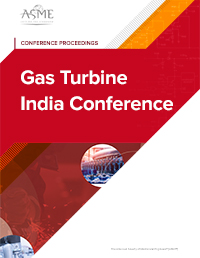This paper describes the steady state numerical work carried out to study the influence of providing stepped tip clearances at various axial locations along the rotor chord on the performance of the single stage transonic axial compressor. Uniform tip clearance study on compressor under consideration showed performance deterioration of compressor at higher tip clearance of 2mm [3.4% of rotor axial chord] therefore in order to improve performance of compressor, stepped tip clearance method was introduced. Commercially available Ansys Fluent 12.0 software was used to perform steady state RANS simulations with three dimensional implicit pressure based solver and SST K-ω as turbulence model. Stepped tip clearance concept is based on providing smaller tip clearance in front portion and providing higher tip clearance after step above the rotor. In present case, study was carried out for stepped tip clearance with steps at four different axial locations [i.e. 10, 20, 40 & 60 % of rotor chord from leading edge of rotor] and results were compared with baseline model of 0.5 mm [0.9% of rotor axial chord] uniform tip clearance at 100% speed. The stepped tip clearance combinations used for the analysis was 0.5–2mm. It was observed that there was increase in compressor peak efficiency & peak pressure ratio for all stepped clearance cases. A trend was noticed where there was relative increase in peak efficiency as well as peak pressure ratio when step was moved downstream along rotor chord [i.e. moving from 10% to 60% axial location]for one of the combinations stepped tip clearance. Stall margin improvement was observed for all cases of stepped tip clearance. Stall margin gain obtained was higher when step was provided in front portion above rotor [i.e. 10 & 20 % axial location] compared to stall margin improvement when step was provided in rear portion above rotor [i.e. 40 & 60% axial location]. It can be concluded that stepped tip clearance provided near leading edge shows potential in improving performance for compressor under consideration. Numerical analysis of single stage has been carried out but data has been presented for rotor only to study the flow changes occurring in rotor vicinity created by implementation of stepped tip clearance method.
Skip Nav Destination
ASME 2014 Gas Turbine India Conference
December 15–17, 2014
New Delhi, India
Conference Sponsors:
- International Gas Turbine Institute
ISBN:
978-0-7918-4964-4
PROCEEDINGS PAPER
Numerically Understanding the Steady State Response of Single Stage Transonic Axial Flow Compressor to Axial Locations of Step for Stepped Tip Clearance
Hardik K. Vashi,
Hardik K. Vashi
Maharaja Sayajirao University, Vadodara, Gujarat, India
Search for other works by this author on:
Dilipkumar Bhanudasji Alone,
Dilipkumar Bhanudasji Alone
CSIR-National Aerospace Laboratories, Bangalore, Karnataka, India
Search for other works by this author on:
Harish S. Choksi
Harish S. Choksi
Maharaja Sayajirao University, Vadodara, Gujarat, India
Search for other works by this author on:
Hardik K. Vashi
Maharaja Sayajirao University, Vadodara, Gujarat, India
Dilipkumar Bhanudasji Alone
CSIR-National Aerospace Laboratories, Bangalore, Karnataka, India
Harish S. Choksi
Maharaja Sayajirao University, Vadodara, Gujarat, India
Paper No:
GTINDIA2014-8147, V001T01A003; 12 pages
Published Online:
February 19, 2015
Citation
Vashi, HK, Alone, DB, & Choksi, HS. "Numerically Understanding the Steady State Response of Single Stage Transonic Axial Flow Compressor to Axial Locations of Step for Stepped Tip Clearance." Proceedings of the ASME 2014 Gas Turbine India Conference. ASME 2014 Gas Turbine India Conference. New Delhi, India. December 15–17, 2014. V001T01A003. ASME. https://doi.org/10.1115/GTINDIA2014-8147
Download citation file:
19
Views
Related Proceedings Papers
Related Articles
Modeling Shrouded Stator Cavity Flows in Axial-Flow Compressors
J. Turbomach (January,2000)
Analysis of Aerodynamically Induced Whirling Forces in Axial Flow Compressors
J. Turbomach (October,2000)
Flow Analyses in a Single-Stage Propulsion Pump
J. Turbomach (April,1996)
Related Chapters
Aerodynamic Performance Analysis
Axial-Flow Compressors
Introduction
Axial-Flow Compressors
Introduction
Centrifugal Compressors: A Strategy for Aerodynamic Design and Analysis












